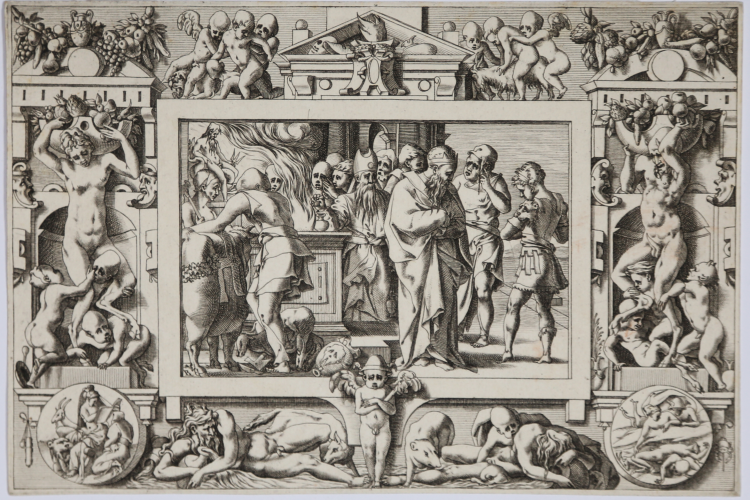



| Reference: | S38433 |
| Author | Renè BOYVIN |
| Year: | 1563 |
| Measures: | 234 x 159 mm |


| Reference: | S38433 |
| Author | Renè BOYVIN |
| Year: | 1563 |
| Measures: | 234 x 159 mm |
Engraving, 1563, signed with monogram B, at lower left of the image.
Good example, printed on contemporary laid paper, without the Latin caption benath the image.
Plate 4 from a series of twenty-six prints relating the myth of Jason, engraved by Boyvin after Leonard Thiry.
Each scene is framed by an ornate border, the caption below is inscribed in a cartouche and printed from a separate plate.
The set was published in 1563 and it was preceded by a letterpress text: privilege, dedication to the King, and four pages on the story of Jason.
Two editions were issued at the same time: a Latin edition, with a Latin title "Hystoria Iasonis Thessaliae Principis de Cochica..." and Latin captions; and a French edition, with a French title "Livre des la conqueste de la Toison d'or par le prince Jason de Tessalie..."
|
Robert-Dumesnil, Le peintre graveur français, v. 8, p. 36-44, n. 39-64.
|
Renè BOYVIN (Angers 1525 ca. - Roma 1580 ca.)
|
French engraver, etcher and designer. Vasari, in his Vita of Marcantonio Raimondi, mentions that ‘after the death of Rosso [Fiorentino], we saw the arrival from France of all the engravings of his works’. He attributed this upsurge of engraved reproductions ‘to the copperplate engraver René’, that is René Boyvin. He came to Paris c. 1545 from Angers, where he was an associate of the mint. In Paris he might have been in contact with Antonio Fantuzzi, and he is known to have renewed a contract of service with the engraver Pierre Milan in 1549. In 1553 he completed two plates that Milan had failed to finish for the music publisher Guillaume Morlaye (c. 1510–after 1558); one of these was the Nymph of Fontainebleau. He later opened his own workshop, and it is known that Lorenzo Penni, the son of Luca, was working for him in October 1557. Boyvin survived for many years despite the Calvinist beliefs for which he was imprisoned in January 1569. He seems to have published nothing under his own name between 1569 and 1574. His last dated work is from 1580, but it appears that he was still alive well into the 17th century.
|
|
Robert-Dumesnil, Le peintre graveur français, v. 8, p. 36-44, n. 39-64.
|
Renè BOYVIN (Angers 1525 ca. - Roma 1580 ca.)
|
French engraver, etcher and designer. Vasari, in his Vita of Marcantonio Raimondi, mentions that ‘after the death of Rosso [Fiorentino], we saw the arrival from France of all the engravings of his works’. He attributed this upsurge of engraved reproductions ‘to the copperplate engraver René’, that is René Boyvin. He came to Paris c. 1545 from Angers, where he was an associate of the mint. In Paris he might have been in contact with Antonio Fantuzzi, and he is known to have renewed a contract of service with the engraver Pierre Milan in 1549. In 1553 he completed two plates that Milan had failed to finish for the music publisher Guillaume Morlaye (c. 1510–after 1558); one of these was the Nymph of Fontainebleau. He later opened his own workshop, and it is known that Lorenzo Penni, the son of Luca, was working for him in October 1557. Boyvin survived for many years despite the Calvinist beliefs for which he was imprisoned in January 1569. He seems to have published nothing under his own name between 1569 and 1574. His last dated work is from 1580, but it appears that he was still alive well into the 17th century.
|